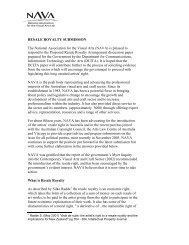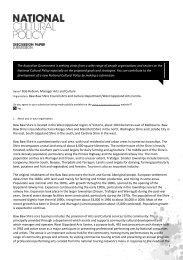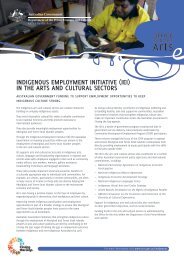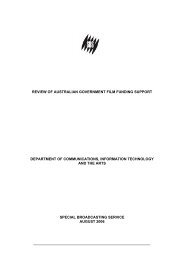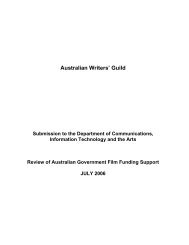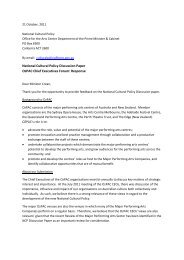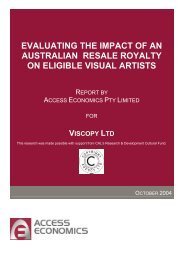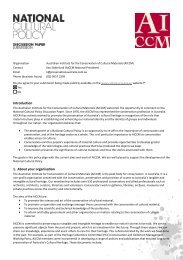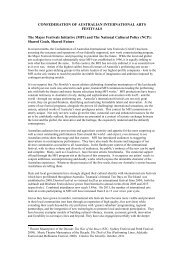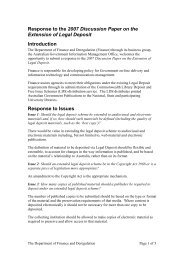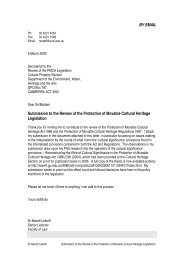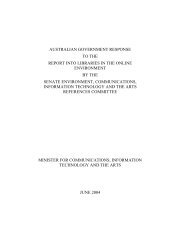Casula Powerhouse Arts Centre - Creative Australia
Casula Powerhouse Arts Centre - Creative Australia
Casula Powerhouse Arts Centre - Creative Australia
You also want an ePaper? Increase the reach of your titles
YUMPU automatically turns print PDFs into web optimized ePapers that Google loves.
The <strong>Australia</strong>n Government is seeking views from a wide range of people organisations and sectors on theNational Cultural Policy especially on the proposed goals and strategies. You can contribute to thedevelopment of a new National Cultural Policy by making a submission.Name* Kiersten FishburnOrganisation <strong>Casula</strong> <strong>Powerhouse</strong> <strong>Arts</strong> <strong>Centre</strong>Do you agree to your submission being made publicly available on the www.culture.arts.gov.au website?*X Yes1. About you or your organisation<strong>Casula</strong> <strong>Powerhouse</strong> <strong>Arts</strong> <strong>Centre</strong> (CPAC) is the cultural facility of Liverpool City Council, NSW. CPAC is a multi-disciplinary arts centre that hassix galleries (with changing exhibitions produced and presented by CPAC), a 326-seat theatre, artist studios, Clayhouse Ceramics Studio,live-in facilities for artists, internal and external public artworks, collection storage facility, retail areas including café and bar, and greenopen spaces. CPAC runs a multi-disciplinary arts program that includes exhibitions, theatre, live music, dance, workshops, seminars andeducation programs. Council owns the building and contributes core operational funding. <strong>Casula</strong> <strong>Powerhouse</strong> <strong>Arts</strong> <strong>Centre</strong> operations aregoverned by an advisory board that reports to Council. The Chair of the Board is the Mayor.In addition, CPAC receives funding from a variety of stakeholders including <strong>Arts</strong> NSW and the NSW State Government to deliver culturalservices focused on State Government strategies of sustainability, equity and ‘quality of life’ in South West Sydney. <strong>Casula</strong> <strong>Powerhouse</strong><strong>Arts</strong> <strong>Centre</strong> also receives project-funding from the Federal Government through the <strong>Australia</strong> Council for the <strong>Arts</strong>.Located on Dharawal country, the banks of the Georges River within the City of Liverpool, CPAC is uniquely placed near major motorwaysand with a dedicated railway station link from Macarthur to the Central CBD of Sydney. It is the main arts facility servicing the South Westof Sydney. <strong>Casula</strong> <strong>Powerhouse</strong> <strong>Arts</strong> <strong>Centre</strong> aims to create a space in which different communities interact and exchange ideas,philosophies, cultures, art forms. This program engages with communities and resonates locally, nationally and internationally.We aim to create a centre that is appreciated by everyone within the community. This will be reflected through intangible factors such aspride and the knowledge that when audience visit they will have fun yet may find that their personal views will be challenged. Tangiblemeasures of success will include high visitation figures and a sustainable cultural facility through income generation.A longer term aim of the centre is to build dynamic creative industries for the region based on respectful relationships between audiencesand stakeholders.Our Vision is contribute to an inclusive and creative community through the presentation and production of compelling, quality anddiverse cultural programs relevant and engaging to South Western Sydney communities.This response has been prepared by Kiersten Fishburn, Director, <strong>Casula</strong> <strong>Powerhouse</strong> <strong>Arts</strong> <strong>Centre</strong> – Liverpool City Council.2. Do you support the development of a National Cultural Policy, and why?The development of a National Cultural Policy is a much needed opportunity to ignite debate and discussion about the values and prioritiesof the arts and culture in <strong>Australia</strong>. Even the process of engaging with the discussion paper has opened conversation and thinking aboutquestions that should be critical to all arts practice – what is diversity? Who decides excellence? What is the role of the arts in communityhealth and development? The fact that the arts sector is actively engaging with broad issues around the meaning of the arts, the way it issupported and valued, and concepts of excellence and innovation is of value in itself. This is also an excellent opportunity to build on theideas generated from the 2020 Summit. We hope that like <strong>Creative</strong> Nation before it, this National Policy will reinvigorate and re-engage1
oth the arts sector and the broader community to think deeply about the ways that the arts shape and speak for and to contemporary<strong>Australia</strong>.The opportunity to coalesce this thinking into a Policy framework that will, hopefully, shape funding and support is a very exciting one. Webelieve however, that a Policy alone will not deliver on the Goals and that a review of funding mechanisms and support must also beundertaken. In particular we hope that this will be an opportunity to clarify the different roles across the three tiers of government inrelation to support for the arts and culture. For artists and many arts organisations, the current system is complex, impenetrable andinequitable. It is also heavily dependent on local government’s continuing contribution to cultural facilities and to grassroots andcommunity-based programming with seemingly little recognition of the value of this contribution when any National cultural discussionoccurs. We are very interested to see what plans are being considered for a wider review of the National responsibility for, and currentsupport of, arts and culture.We also believe that the discussion paper is just one step in the development of the Policy and that further consultation is required toensure that actions are grounded and achievable and that measures of success are agreed upon across the arts and cultural sector. At thispoint any responses are limited due to the lack of a clear plan for delivery – including timelines, expectations, targets and methods. Whilewe recognise the need for flexibility at this point to ensure that submissions are wide-reaching, there is another conversation that isrequired with the arts sector once a delivery plan is produced.In general, we suggest the development of working groups for each of the Goals with members taken from both arts practitioners andrepresenting organisations across the diversity of the arts and different communities. These working groups should be used to bothdevelop tangible actions for the goals and to measure the success in delivering on them. These working groups should also be used togenerally consult within the arts community and to report back to ensure that the Policy remains active and living.3. What are your views about each of the four goals?GOAL 1: To ensure that what the Government supports — and how this support is provided — reflects thediversity of a 21 st century <strong>Australia</strong>, and protects and supports Indigenous cultureGOAL 2: To encourage the use of emerging technologies and new ideas that support the development of newartworks and the creative industries, and that enable more people to access and participate in arts and cultureGOAL 3: To support excellence and world-class endeavour, and strengthen the role that the arts play in telling<strong>Australia</strong>n stories both here and overseasGOAL 4: To increase and strengthen the capacity of the arts to contribute to our society and economyBackground:The list of core arts that the Policy will encompass does not include community arts (or community-based practice). This is a seriousomission as this is a legitimate form of art practice through which many people make their first and continuing engagement with the arts.Gastronomy is also an area in which <strong>Australia</strong> excels and where a strong case can be made for it as a creative industry and as culturalexpression (particularly for non-English speaking communities).We also suggest that festivals and events are listed as ways that the public can engage with the arts (this is particularly the case outside ofcity centres).2
Goal One:We are pleased that Indigenous culture is recognised in the first Goal but feel that this does not go far enough to acknowledge thetraditional owners and custodians of their land and their primacy in the culture of <strong>Australia</strong>. We suggest a preamble that clearlyacknowledges the contribution of Aboriginal and Torres Strait Islander cultures both past and present. This should also acknowledge thediversity of cultures within the Indigenous community. This could be an expanded version of the Cultural Heritage definition but wouldneed to include a clearer recognition of contemporary, living Indigenous culture.We believe that it is critical that Indigenous culture (and cultural and community diversity generally) is recognised as being at the heart ofall of the Goals. We stress the term “community diversity” as this speaks to difference generally and acknowledges the inclusion of all typesof expression and ‘stories’.We also believe that in articulating the actions for Goal One the idea of funding to support complexity within diversity should beencouraged. This recognises that there are many positions from which an artist might wish to speak – not always including their culturalbackground. It also encourages a contemporary reading of cultural diversity that is based around how practice is impacted by culture, age,gender, disability etc, and that does not assume that any artist speaks from one permanently fixed position.As a local government owned cultural centre, we can not stress strongly enough that serious work needs to be undertaken to resolve theresponsibilities and relationships across Federal, State and Local Government. This is not just in relation to funding (although that iscritical), but also impacts on marketing, promotion, audience development and the recognition of less mainstream arts practice (whichgenerally comes out of, or is only supported by, a community or local government institution).We strongly support any audience development strategies, especially those that engage with non-traditional arts audiences, and would liketo see resources and support provided for audience development to be undertaken with new arts communities and in non city centrebased arts facilities.Goal Two:This Goal seems to be confusing an ambition, ‘innovation’ with an action, ‘use of new technology’. We suggest that the Goal should be rewrittenso that it is encouraging innovation in arts practice generally including through the use of new art forms and technologies.Technology should be considered a means to an ends, not the ends in itself.We strongly support the use of new technologies to develop audiences, however this more logically sits in Goal One where againtechnology is the means to the ends of achieving greater access to the arts. Any strategies developed for this outcome must ensure thataccess is considered in every sense to overcome barriers (disability, language, geography, education). If this is not done then the artsbecomes further ‘elite’ by being accessible only to the technologically literate and privileged. Hopefully the NBN will resolve many of thesebarriers.It is however critical to ensure that the delivery of new technologies through the NBN actually complements the live experience ratherthan being an excuse not to take live experiences outside of city centres (for example, why tour a work when you can stream it into aregional cinema?)To ensure that innovation through new technology flourishes policies around classification and internet content censoring must becarefully developed to ensure that they do not interfere with innovation in the arts and the development of new artforms and artexperiences.We are also very interested in the development of the creative industries outside of city centres and hope that this in this Goal there isrecognition that these are industries that can contribute to communities, and be sustainable, in areas that are regional or outermetropolitan.3
Goal Three:The idea of who determines ‘excellence’ and what is an ‘<strong>Australia</strong>n story’ is a critical one. As an arts institution representing communitybased practice and grounded in community development principles, the definition of ‘excellence’ has been an often fraught one. We lookto this Policy (and subsequent funding reform) to broaden this definition and to acknowledge excellence in ways that are more complexthan Awards or prizes (for example community wellbeing outcomes). A best practice definition that focuses on ‘quality’ rather than‘excellence’ may be more inclusive and less problematic.Excellence and world-class standards are not unique to major funded organisations and individuals as implied, they exist at every level ofthe arts and in diverse communities and this needs to be recognised. This could be expressed if there was greater encouragement formainstream arts organisations to program in work that has been developed out of community, regional or non-mainstream artists and artsorganisations.The idea of an ‘<strong>Australia</strong>n story’ is a complex one in itself – who determines what are our stories? How does this include the voices ofcommunities who have more of a diaspora relationship with <strong>Australia</strong>, like many Pacific Islander communities for example? We encouragesupport to less mainstream arts communities, companies and artists to allow them to develop work to a touring level to ensure that thediversity of voices that speak of <strong>Australia</strong> is not lost. The idea of telling ‘<strong>Australia</strong>n stories’ does not clearly encompass the fact that<strong>Australia</strong>n artists and institutions have a well respected, recognised and critical role to employ with engaging with broader global issues.These won’t necessarily fit the reductive idea of an ‘<strong>Australia</strong>n story’ but will nonetheless engage audiences in <strong>Australia</strong> and internationallyand meet definitions of excellence.A National Cultural Policy should also address bringing international arts experiences and product to <strong>Australia</strong>. It is disappointing that thisGoal only speaks to touring work out, not making the commitment to bring work into <strong>Australia</strong> to provide <strong>Australia</strong>ns with a broader globaloutlook and exposure to different forms of expression and models of excellence. A Policy that does not address this aim could be seen tobe embarrassingly parochial.Goal Four:We strongly support strategies that use creative thinking and experiencing the arts to ensure education outcomes and the development ofa knowledge economy. The intersection between arts institutions and creative education is one that can be further developed to thebenefit of both the education community and the arts sector.The area of life-long learning needs to be further developed in relation to this Goal. This not only contributes economically, but has a clearand measurable impact on the health of community. It was also disappointing that little reference has been made to the needs of older<strong>Australia</strong>ns despite our ageing population. There is also a wealth of knowledge and skills residing in ‘senior’ artists and this should berecognised and utilised to mentor and develop emerging artists.An area that we would like to see addressed is skills development and training for arts workers outside of mainstream education. Thiscould include apprenticeships or internships in cultural institutions with formal recognition of the value of those experiences. We alsosuggest that exchanges between arts institutions could broaden the scope of industry skills. The sector would also benefit from thoseworking in funding and policy areas undertaking regular work experience in the sectors for which they are making decisions.One of the most significant issues for arts institutions in seeking funding or sponsorship is that there are no agreed upon metrics for thereporting of economic or social benefit or even ROI. This research is critically needed in the sector and we believe that this will also assist inmaking more equitable and transparent funding decisions.The contribution of the arts and culture to environmental aims and objectives should also be noted. It is the arts that often leads debateand community awareness on this the most pressing issue at this time.4
1. What strategies do you think we could use to achieve each of the four goals?The following are suggestions for actions that could assist in delivering on the Goals.Strategies for Goal One:Review the relationship between Federal, State and Local in funding/supporting the arts and culture and enter into tripartitefunding agreements that will allow delivery on the goals – particularly in the area of diversity and representation.Provide support for audience development officers and tools/resources to be based outside of mainstream arts institutions andaudiences. This may include locating an arts audience development officer within welfare or NGO groups working withcommunities.Support projects and initiatives that are developed in non-mainstream communities (not just ‘for’ them) – this may involveincreasing funding available to community based projects.Develop a marketing/communications campaign that specifically promotes and champions work that is diverse and that has beenproduced by artists/institutions that celebrate and represent a range of cultural and community identities.Ensure funding is available, and that agreements with State and Local Government have been entered into, to ensure that artsinstitutions are physically accessible to people with a disability and to older people.Ensure that all arts organisations and institutions receiving Federal funding have an Access and Inclusion Strategy – including forpeople with a disability and people from a cultural and linguistically diverse background – and that they are taking action on thisStrategy.Ensure that all arts organisations and institutions receiving Federal funding have an Indigenous Cultural Strategy and that theywork collaboratively with the local Aboriginal community (or community representatives through Land Councils etc) to deliver onthis Strategy.Strategies for Goal Two:Encourage innovation through an innovation fund for arts R &D that does not necessarily have a performance/exhibitionoutcome.Develop a promotional campaign focusing on <strong>Australia</strong>n innovation in the arts and creative industries.Provide resources and training to ensure that the use of new technologies by the arts is fully accessible to all audiences.Develop and support a network of creative industry hubs outside of city centres.Provide support and training for smaller arts organisations and artists in using new technologies for marketing, promotion andaudience development.Promote creative industries that are from new and emerging artforms/practices or communities.Strategies for Goal Three:Provide opportunities to debate and discuss the notion of ‘excellence’ both in relation to funding and in reference to which‘<strong>Australia</strong>n stories’ are supported for touring and developmentEnsure that community arts are recognised as having models of excellence and showcase those with other art forms.5
Ensure that funding is available to support community and non-mainstream arts to develop outcomes that are suitable to betoured or showcased nationally or internationally.Encourage mainstream arts organisations to program work developed in communities, regionally or from the non-mainstream.Develop strategies to ensure access to international arts outside of festivals and city centres.Develop a scheme that provides support for local libraries to provide author talks (and writers in residency) by <strong>Australia</strong>n writersto encourage <strong>Australia</strong>ns to engage with the excellence of our own literature.Strategies for Goal Four:Provide a mechanism for people to gain formally recognised experience and training in the arts through paidapprenticeships/internships/exchanges etc.Provide incentives for arts institutions to take on trainees, particularly those from disadvantaged backgrounds.Develop a lifelong learning strategy for the arts and cultural sector and provide support and advice to enact this.Develop a program that utilises the skills and experiences of ‘senior’ artists to mentor and assist in the development of youngerand emerging artists/arts organisations.Provide funding to allow all school students, regardless of economic and geographic background, to have at least one annualexperience of theatre and professionally developed exhibitions.Provide assistance and resources to smaller and not for profit organisations to measure their contributions (economically andsocially – including environmental).Develop consistent and agreed upon metrics for measuring outcomes that can be utilised across the arts and cultural sector.Undertake research into the ways that the arts and culture does and can contribute to meeting environmental aims andobjectives.5. How can you, your organisation or sector contribute to the goals and strategies of the National Cultural Policy?<strong>Casula</strong> <strong>Powerhouse</strong> <strong>Arts</strong> <strong>Centre</strong> (CPAC) is well placed to deliver on the goals of the National Cultural Policy as a leading arts institution inSouth West Sydney. Given the physical location of the centre within South West Sydney, <strong>Casula</strong> <strong>Powerhouse</strong> <strong>Arts</strong> <strong>Centre</strong> programs speakabout living in a culturally complex environment. In turn, this form of engagement assists in the creation of a civil society, and in that civilsociety everyone is involved to the best of their capacity.We are therefore able to actively take part in a cultural dialogue about diversity, difference and identity with over 150 different culturalbackgrounds represented in the Liverpool LGA. As the Liverpool LGA also has one of the largest communities of urban Aboriginal people,we are ideally placed to deliver opportunities for Indigenous cultural representation and discussion. We already provide theseopportunities through:Theatre development and presentationExhibition development and presentation (with the scope to expand more into touring)Talks and public programsWe strongly believe that with investment and support the work being produced out of CPAC will be able to have a national andinternational touring and exhibition life. This is a way in which we can actively contribute to the diversity of ‘<strong>Australia</strong>n stories’ that aretold, and add richness and depth to the <strong>Australia</strong>n arts community.6
We are interested in further developing our work in these areas in alignment with the National Cultural Policy and acting as a recognisedhub for the development of work that speaks to and with diverse communities. We are also able to deliver innovation and excellence inthis area, and in the translation of community based projects into gallery/theatre outcomes. To deliver this we are expanding the work weare undertaking in new technologies and new artforms. As we are located in an area with a significant youth population, we see manyopportunities and a real impetus for both our audiences and practitioners to engage with new technologies.Engagement with new technology further aligns with the plans of CPAC to work towards the development of a South West Sydney creativeindustry hub bringing together a range of cultural disciplines and industry types including design and digital. It is our vision to contribute tomicro-business in the South West through support and facilities, and to assist in developing thriving and sustainable creative industries.<strong>Casula</strong> <strong>Powerhouse</strong> <strong>Arts</strong> <strong>Centre</strong> is concerned with the ‘health’ of its communities and this includes catering for all aspects of thecommunity members’ personas: the arts provide an opportunity for people within South West Sydney to be able to have life-long learningopportunities and/ or a career in the arts. This is particularly evident in the education programs that bring audiences to the <strong>Centre</strong> tocultivate an appreciation of the arts and allow people of all ages who aspire to the arts to get involved and express themselves.Our schools education program is already strong but would be enhanced by a more structured relationship between the various educationsectors (schools and tertiary) with further support for program development. We also contribute to lifelong learning and actively seek toprovide aesthetic and educational experiences across the diversity of our community (age, culture, gender, disability etc).We would also be very interested in expanding our role as an educator to the arts sector generally through providing trainingopportunities. We would be interested to explore the idea of CPAC as a hub for apprenticeships or general arts training schemes fortechnical and administrative positions as well as in creative practice.CPAC as a venue provides opportunities for people in South West Sydney to access with and engage with the arts at all levels. While ourreputation is strongly based in community development and practice, we also use our facilities to showcase the arts across the spectrumincluding everything from contemporary dance and visual art, to musical theatre. Cultural facilities that are based in, and respond to, localcommunities are critical to the health of those communities and CPAC already plays a significant role in this area. With a more strategicrelationship between State, Federal and CPAC (as a Local Government facility) we will be able to further contribute and grow in this (and allother) areas.Finally, but absolutely critically, CPAC is a significant employer in the arts and the investment that Liverpool City Council makes in both thefacility and the programming of CPAC allows for artists to develop new work and skills in a flexible and supportive environment. This isdone through residencies, commissions and workshops and CPAC is interested in expanding our work in these areas and, with appropriateinvestment, acting as a space and facility for the incubation of new creative ideas and experiences.In summary we are able to contribute to the delivery of the National Cultural Policy through:Expert advice and best practice examples in community based workDevelopment and presentation of work (in a range of artforms) that speaks to the diversity of the South West Sydneycommunity, including the significant Indigenous community.Development and touring of work providing a diverse and rich range of ‘<strong>Australia</strong>n Stories’Development of a creative industry hub for South West SydneyActively providing education and lifelong learning in, and through, the arts for the communityProviding apprenticeship or training opportunitiesEmploying artists and artworkers and providing opportunities for their creative development and expression.6 Are there any other goals you would like to see included in the National Cultural Policy?The key area that that we believe should be made more explicit as a Goal in its own right is valuing the work of artists and ensuringemployment opportunities. We propose:7
To value and support the contribution that artists make to the <strong>Australia</strong> community and economy, and to ensure that employment,training and development opportunities are made available throughout their careers.While this is implicit in the proposed Goals, we believe that it is critical that artists are recognised in their own right as being at the coreand heart of all arts activities and that a National Policy acknowledges this. The issue of employment for artists is of course a critical one –with many artists finding it increasingly difficult to undertake their arts practice without other forms of employment. Tax incentives,bursaries, subsidies and training opportunities are all potential strategies to help overcome these issues and we believe that they should beexplored and addressed in the development of the Policy.8




